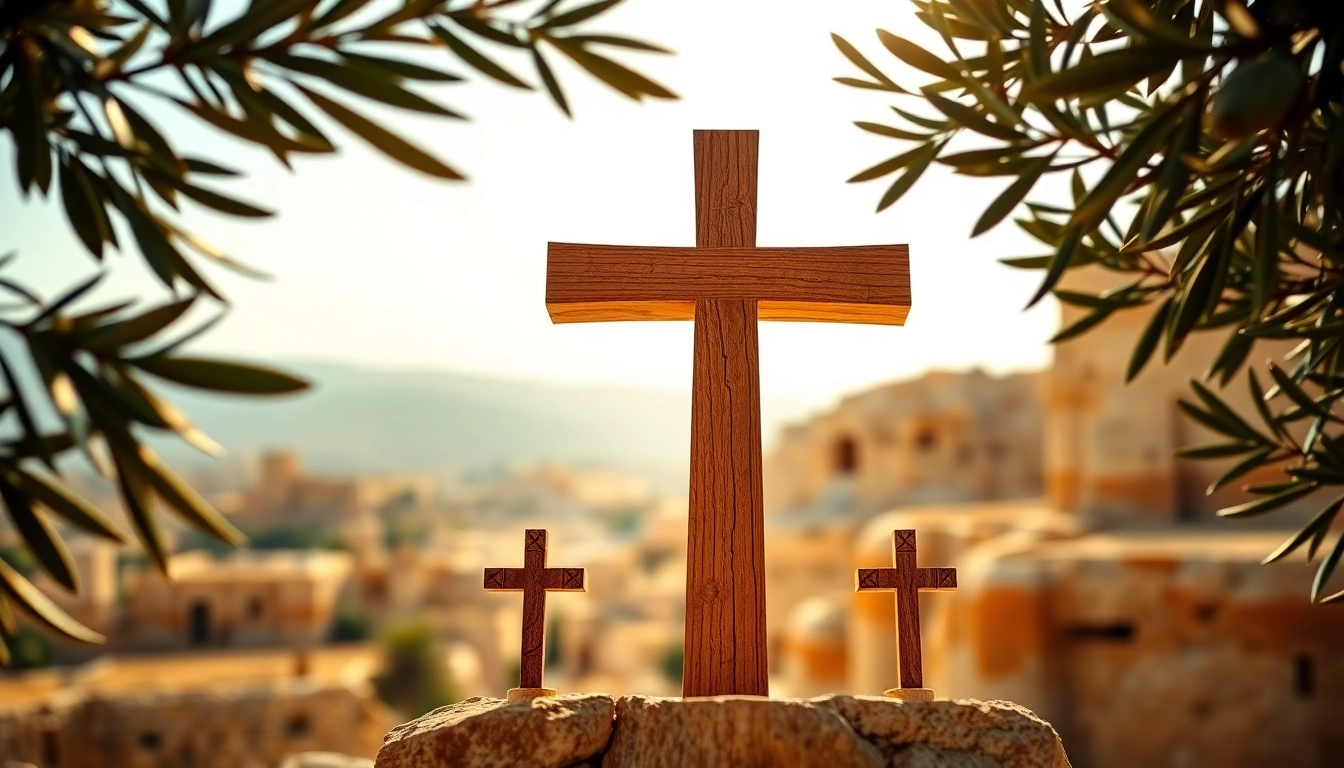Understanding Jerusalem Crosses
What are Jerusalem Crosses?
The Jerusalem crosses are emblematic symbols in Christian heritage, recognized not only for their religious significance but also for their unique design. This heraldic cross, often referred to as the “five-fold cross” or the “cross-and-crosslets,” consists of a large central cross potent, surrounded by four smaller Greek crosses positioned at each quadrant. This distinctive structure is not merely aesthetic; it embodies profound spiritual and theological meanings central to Christianity.
Historical Background of Jerusalem Crosses
The origins of the Jerusalem cross trace back to the medieval period, particularly in the 11th century during the era of the Crusades. It was adopted as the symbol for the Kingdom of Jerusalem, a Christian state established following the First Crusade. The cross represented not only the power and authority of the Crusader states but also the mission to spread Christianity and the biblical gospel. Over centuries, this emblem has undergone transformations and adaptations, reflecting the changes within Christian communities and interpretations.
The Symbolism Behind Jerusalem Crosses
The symbolism of the Jerusalem cross is rich and layered. Each of the five crosses holds distinct meanings: the large central cross symbolizes Christ’s dominion over the world, while the four smaller crosses represent the Four Evangelists—Matthew, Mark, Luke, and John—who carried the message of Jesus beyond Jerusalem to the four corners of the earth. Thus, the emblem encapsulates the mission of the Church to disseminate the teachings of Christ universally. Furthermore, the Jerusalem cross is sometimes interpreted to signify the five wounds of Christ, further intertwining the symbol with the story of redemption and sacrifice.
Design Variations of Jerusalem Crosses
Materials Used in Crafting Jerusalem Crosses
Jerusalem crosses are crafted from a variety of materials, with each choice adding a layer of significance and interpretation. Traditionally, olive wood sourced from the Holy Land is a popular material, symbolizing peace and prosperity. Artisans also use metals such as gold, silver, and bronze to create more elaborate designs that are often adorned with gemstones or enamel to enhance their visual appeal. Each material not only contributes to the overall aesthetic but also serves a symbolic purpose, often rooted in the traditions and history of the regions from which the cross originates.
Common Design Elements and Their Meanings
Beyond the structural aspects of the Jerusalem cross, several design elements are commonly incorporated, each bearing its own significance. For instance, many artisans choose to engrave the Latin phrase “In hoc signo vinces,” meaning “In this sign, you will conquer,” around the cross. This phrase resonates with the historical context of the Crusades and serves as a reminder of faith and perseverance. Additionally, some designs may feature motifs such as laurel leaves or flowers, symbolizing resurrection and eternal life. The incorporation of these elements creates a narrative that enriches the viewer’s understanding of the cross’s significance.
Regional Variations of Jerusalem Cross Designs
Across different cultures and regions, Jerusalem crosses present unique variations in design. These regional differences often reflect local artistic traditions and spiritual interpretations. For example, the Ethiopian versions might incorporate intricate designs blending local artistic motifs with the basic cross structure, symbolizing a deep cultural integration of faith and identity. In contrast, crosses found in Western art may lean towards minimalistic interpretations that emphasize elegance. Such variations not only enrich the cross’s visual diversity but also remind us of the universal nature of its message.
Importance in Christian Traditions
The Role of Jerusalem Crosses in Worship
Jerusalem crosses play a pivotal role in Christian worship and liturgy. They are often used in church services as symbols of faith and devotion, and many congregations proudly display Jerusalem crosses in their sanctuaries and homes. This prominence enhances the communal identity among believers, fostering a collective sense of purpose tied to the broader Christian mission. Additionally, during religious milestones such as baptisms, confirmations, or weddings, these crosses may be presented as gifts, serving as a tangible reminder of faith and the importance of community in a believer’s spiritual journey.
Jerusalem Crosses in Religious Ceremonies
In many Christian traditions, Jerusalem crosses are integral to religious ceremonies, representing the dedication of the faithful. For example, during Easter, large Jerusalem crosses may be positioned prominently in processions, symbolizing the resurrection of Christ. During weddings, couples may exchange Jerusalem crosses as tokens to signify their commitment to each other and their shared faith. These moments create a powerful connection between the physical symbol of the cross and the spiritual commitments being made, reinforcing the values of love, sacrifice, and faith.
Personal Significance of Jerusalem Crosses for Believers
For many believers, wearing or displaying a Jerusalem cross carries profound personal significance. It serves as a touchstone for faith, a visual reminder of the teachings of Christ and the individual’s commitment to live out those principles. Many find comfort and strength in their connection to this symbol, viewing it as a source of inspiration in times of trouble or uncertainty. Moreover, the Jerusalem cross often acts as a conversation starter, inviting discussions about faith and spirituality, and allowing believers to share their personal stories and understandings of what their faith means to them.
Modern Interpretations and Usage
Contemporary Art and Jerusalem Crosses
The Jerusalem cross has been reinterpreted in various forms of contemporary art, reflecting both traditional themes and modern aesthetics. Many artists draw inspiration from its historical significance to create works that challenge or provoke thought regarding moral and spiritual issues. This includes paintings, sculptures, and digital art that encompass the essence of the Jerusalem cross while reflecting current societal concerns or personal narratives. As a result, these contemporary forms redefine the cross’s significance, making it relevant in today’s cultural discourse.
Jerusalem Crosses in Fashion and Jewelry
In recent years, there has been a growing trend of incorporating Jerusalem crosses into fashion, particularly in jewelry. Designers have taken the traditional design and adapted it into necklaces, bracelets, and pendants that appeal to a broader audience. These pieces transcend mere accessories by representing personal faith and identity. Many individuals choose to wear them as a statement of belief or as a way to express their connection to their heritage. This crossover between religious symbolism and personal expression exemplifies the continuing relevance of the Jerusalem cross in contemporary culture.
How to Incorporate Jerusalem Crosses into Daily Life
Incorporating Jerusalem crosses into daily life can foster a deeper connection with one’s faith. This can be achieved through simple actions, such as wearing a cross pendant or using home decor items that feature the symbol. Additionally, engaging with art forms that feature the Jerusalem cross, whether through purchase or creation, can serve as a daily reminder of personal beliefs. Individuals may also choose to use the cross as a focal point for personal prayers or reflections, enhancing their spiritual practice and encouraging mindfulness in everyday life.
Where to Buy Authentic Jerusalem Crosses
Reputable Artisans and Craftsmanship
When seeking authentic Jerusalem crosses, it is crucial to identify reputable artisans known for their craftsmanship. Many skilled artisans in Jerusalem and surrounding regions produce crosses that reflect both traditional designs and high-quality workmanship. Engaging directly with artisans can also provide insights into the story behind the piece, enriching the experience of ownership. Furthermore, local markets and community fairs often showcase craftspeople whose work embodies the cultural and spiritual significance of Jerusalem crosses.
Online Stores Offering Jerusalem Crosses
Various online retailers specialize in selling Jerusalem crosses. Websites that focus on religious artifacts and gifts often feature a wide selection of crosses made from different materials, designs, and price ranges. Buyers should ensure that they are purchasing from trusted online platforms that guarantee authenticity and quality. Reviews and feedback from previous customers can serve as a helpful guide in selecting a reliable vendor when browsing online.
Evaluating Authenticity and Quality of Jerusalem Crosses
When purchasing a Jerusalem cross, authenticity and quality are paramount. Buyers should look for signs of quality craftsmanship, such as intricate detailing and a well-finished product. Additionally, understanding the materials used can help in assessing the durability and authenticity of the piece. It is beneficial to request certifications or proof of origin from the seller, especially when it comes to more expensive items. Comparing prices across different vendors can also provide insights into fair market value, ensuring that buyers are making informed decisions.



